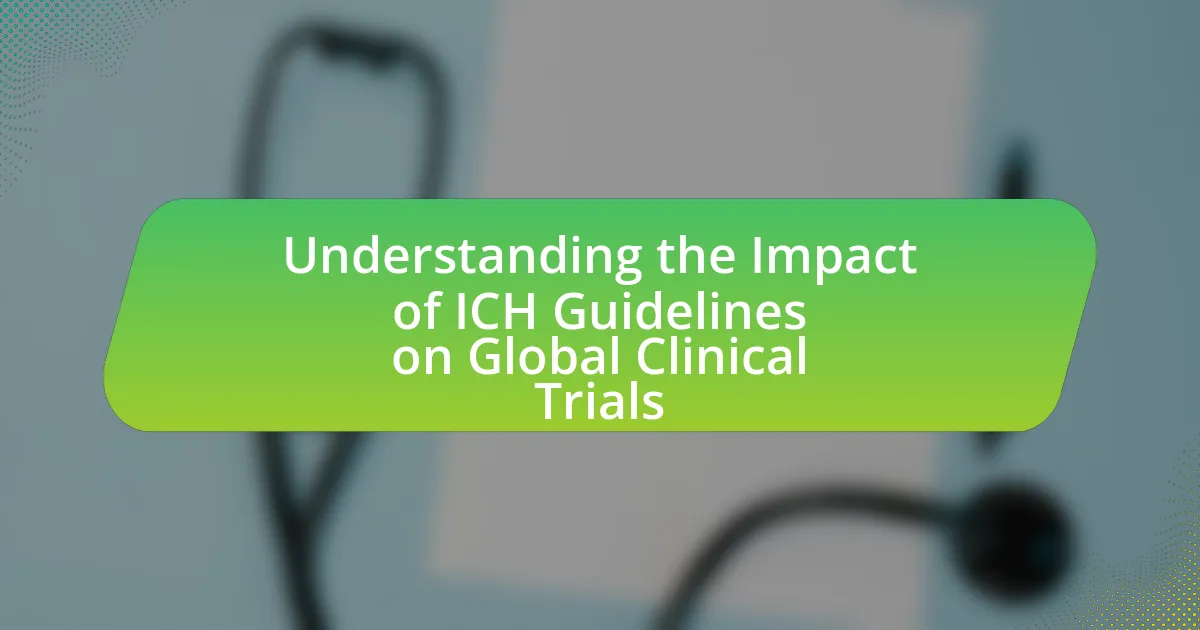The article focuses on the critical role of Regulatory Affairs in ensuring patient safety within clinical research. It outlines how Regulatory Affairs professionals ensure compliance with laws and regulations governing medical product development, including the preparation and submission of documentation to regulatory bodies like the FDA and EMA. Key responsibilities include monitoring clinical trials for adherence to Good Clinical Practice (GCP) guidelines, conducting risk assessments, and facilitating communication among stakeholders. The article also discusses the challenges faced in regulatory compliance, the impact of regulations on patient safety, and best practices for enhancing safety outcomes in clinical trials.

What is the Role of Regulatory Affairs in Clinical Research?
Regulatory affairs in clinical research primarily ensure compliance with laws and regulations governing the development and testing of new medical products. This role involves the preparation and submission of documentation to regulatory bodies, such as the FDA or EMA, to obtain approval for clinical trials and marketing. Regulatory affairs professionals also monitor ongoing studies to ensure adherence to Good Clinical Practice (GCP) guidelines, which are essential for protecting participant safety and data integrity. By facilitating communication between sponsors and regulatory agencies, they help navigate the complex regulatory landscape, ensuring that clinical research is conducted ethically and safely.
How do Regulatory Affairs contribute to Patient Safety?
Regulatory Affairs contribute to Patient Safety by ensuring that medical products meet safety and efficacy standards before they reach the market. This is achieved through rigorous evaluation processes, including clinical trials that assess the risks and benefits of new treatments. Regulatory bodies, such as the FDA, require comprehensive data on product safety, which includes adverse event reporting and post-market surveillance to monitor ongoing safety. For instance, the FDA’s REMS (Risk Evaluation and Mitigation Strategies) program mandates specific safety measures for certain medications to minimize risks to patients. By enforcing these regulations, Regulatory Affairs play a crucial role in protecting patients from unsafe products and ensuring that only those that have been thoroughly vetted for safety are available for public use.
What are the key responsibilities of Regulatory Affairs professionals?
Regulatory Affairs professionals are primarily responsible for ensuring that companies comply with all regulations and laws pertaining to their products, particularly in the pharmaceutical and medical device industries. They manage the submission of regulatory documents to health authorities, ensuring that products meet safety and efficacy standards before they can be marketed. Additionally, they monitor ongoing compliance with regulations throughout the product lifecycle, including post-market surveillance and reporting adverse events. Their role is critical in facilitating communication between the company and regulatory agencies, thereby ensuring that patient safety is prioritized in clinical research and product development.
How do these responsibilities impact patient safety in clinical trials?
Responsibilities in regulatory affairs directly impact patient safety in clinical trials by ensuring compliance with established guidelines and protocols. These responsibilities include monitoring trial conduct, reviewing informed consent processes, and overseeing adverse event reporting. For instance, adherence to Good Clinical Practice (GCP) guidelines minimizes risks by ensuring that trials are designed and conducted ethically, which has been shown to reduce the incidence of serious adverse events. Furthermore, regulatory bodies like the FDA and EMA require rigorous safety assessments before trial approval, which helps protect participants from potential harm. This systematic oversight is crucial in maintaining high safety standards throughout the clinical trial process.
Why is Regulatory Compliance essential in Clinical Research?
Regulatory compliance is essential in clinical research because it ensures the safety, efficacy, and ethical treatment of participants. Compliance with regulations, such as those set by the FDA and EMA, mandates rigorous protocols that protect human subjects from harm and ensure that the data collected is reliable and valid. For instance, adherence to Good Clinical Practice (GCP) guidelines helps maintain the integrity of clinical trials, which is crucial for obtaining accurate results that can lead to safe and effective medical treatments. Furthermore, regulatory compliance fosters public trust in the research process, as it demonstrates a commitment to ethical standards and accountability in the pursuit of scientific knowledge.
What regulations govern clinical research and patient safety?
The regulations that govern clinical research and patient safety primarily include the Good Clinical Practice (GCP) guidelines, the Declaration of Helsinki, and the U.S. Food and Drug Administration (FDA) regulations. GCP guidelines, established by the International Council for Harmonisation (ICH), ensure that clinical trials are conducted ethically and that the rights, safety, and well-being of trial participants are protected. The Declaration of Helsinki, developed by the World Medical Association, provides ethical principles for medical research involving human subjects, emphasizing informed consent and the necessity of risk-benefit assessments. Additionally, the FDA regulations, particularly Title 21 of the Code of Federal Regulations (CFR), outline requirements for the conduct of clinical trials in the United States, including the need for Institutional Review Board (IRB) approval and adherence to safety reporting standards. These regulations collectively ensure that clinical research is conducted responsibly, prioritizing patient safety and ethical standards.
How do these regulations ensure ethical standards are met?
Regulations ensure ethical standards are met by establishing clear guidelines that govern the conduct of clinical research. These guidelines require informed consent from participants, ensuring they understand the risks and benefits of the study, which is a fundamental ethical principle. Additionally, regulatory bodies like the FDA and EMA mandate that research protocols undergo rigorous review by Institutional Review Boards (IRBs) to assess ethical considerations and participant safety. For instance, the Declaration of Helsinki outlines ethical principles for medical research involving human subjects, emphasizing the necessity of prioritizing participant welfare. Compliance with these regulations is enforced through regular audits and inspections, which help maintain accountability and transparency in clinical trials.
What challenges do Regulatory Affairs face in ensuring Patient Safety?
Regulatory Affairs face significant challenges in ensuring patient safety, primarily due to the complexity of regulatory requirements and the rapid pace of medical innovation. The evolving landscape of regulations often leads to difficulties in maintaining compliance, as new therapies and technologies emerge faster than guidelines can be established. Additionally, the need for thorough risk assessment and management complicates the process, as it requires extensive data collection and analysis to identify potential safety issues. Furthermore, the integration of diverse stakeholder perspectives, including those of patients, healthcare providers, and regulatory bodies, adds layers of complexity to decision-making processes. These challenges are underscored by the increasing scrutiny from regulatory agencies, which demand rigorous evidence of safety and efficacy before approval, as seen in the stringent requirements set by the FDA and EMA for new drug applications.
What are common obstacles in the regulatory approval process?
Common obstacles in the regulatory approval process include lengthy review times, insufficient data submission, and evolving regulatory requirements. Lengthy review times can delay the introduction of new therapies, as seen in the average time of 10 months for the FDA to review new drug applications. Insufficient data submission often leads to requests for additional information, prolonging the process; for instance, 30% of applications are returned for more data. Evolving regulatory requirements can create confusion and necessitate additional compliance efforts, impacting timelines and resources. These obstacles collectively hinder the efficiency of bringing safe and effective treatments to market.
How can these challenges affect patient outcomes?
Challenges in regulatory affairs can significantly affect patient outcomes by leading to delays in the approval of clinical trials and therapies. For instance, stringent regulatory requirements may prolong the time it takes for new treatments to reach patients, which can result in worsening health conditions or increased mortality rates for those awaiting effective therapies. A study published in the Journal of Clinical Oncology found that delays in drug approval processes can lead to a loss of approximately 10,000 lives annually in the United States alone. Additionally, inadequate regulatory oversight can result in the approval of unsafe or ineffective treatments, directly compromising patient safety and health outcomes.
How do Regulatory Affairs interact with other stakeholders in Clinical Research?
Regulatory Affairs interact with other stakeholders in Clinical Research by ensuring compliance with regulatory requirements and facilitating communication among parties such as sponsors, clinical investigators, ethics committees, and regulatory agencies. This interaction is crucial for the development and approval of new therapies, as Regulatory Affairs professionals provide guidance on regulatory submissions, monitor trial progress, and address any compliance issues that may arise. For instance, they prepare and submit Investigational New Drug applications to the FDA, ensuring that all necessary data is included to support patient safety and efficacy claims. This collaborative approach helps streamline the clinical trial process and enhances the overall safety and efficacy of new medical products.
What specific roles do Regulatory Affairs play in the clinical trial process?
Regulatory Affairs play critical roles in the clinical trial process by ensuring compliance with legal and ethical standards. They are responsible for preparing and submitting regulatory documents to health authorities, such as Investigational New Drug applications, which are essential for obtaining approval to initiate clinical trials. Additionally, Regulatory Affairs professionals monitor trial progress to ensure adherence to regulatory requirements and facilitate communication between sponsors and regulatory bodies. Their involvement is crucial for maintaining patient safety, as they assess trial protocols for ethical considerations and ensure that informed consent processes are properly implemented. This oversight helps to protect participants and uphold the integrity of the clinical research process.
How do they collaborate with clinical researchers and ethics committees?
Regulatory affairs professionals collaborate with clinical researchers and ethics committees by ensuring compliance with regulatory standards and ethical guidelines throughout the research process. They facilitate communication between researchers and ethics committees, helping to prepare and submit necessary documentation, such as study protocols and informed consent forms, which are essential for ethical review. This collaboration is crucial for maintaining patient safety, as regulatory affairs professionals monitor adherence to regulations like the Declaration of Helsinki and Good Clinical Practice, which mandate ethical considerations in clinical trials. Their involvement ensures that all aspects of the research align with both regulatory requirements and ethical standards, ultimately protecting participants and enhancing the integrity of the research.
What is the importance of communication between Regulatory Affairs and clinical teams?
Effective communication between Regulatory Affairs and clinical teams is crucial for ensuring compliance with regulatory requirements and safeguarding patient safety in clinical research. This collaboration facilitates the timely exchange of information regarding trial protocols, regulatory submissions, and safety data, which is essential for making informed decisions. For instance, clear communication helps in identifying potential risks early, allowing for prompt action to mitigate them, thereby enhancing the overall integrity of the clinical trial process. Moreover, studies have shown that organizations with strong interdepartmental communication experience fewer compliance issues and improved trial outcomes, underscoring the importance of this relationship in maintaining patient safety and regulatory adherence.
What are the best practices for Regulatory Affairs to enhance Patient Safety?
The best practices for Regulatory Affairs to enhance Patient Safety include rigorous risk assessment, continuous monitoring of clinical trials, and effective communication with stakeholders. Regulatory Affairs professionals should conduct thorough risk assessments to identify potential safety issues early in the clinical research process, ensuring that appropriate mitigation strategies are in place. Continuous monitoring involves regularly reviewing safety data and adverse event reports to promptly address any emerging safety concerns, which is critical for maintaining patient safety throughout the trial. Effective communication with stakeholders, including regulatory bodies, clinical investigators, and patients, ensures that all parties are informed about safety protocols and any changes in risk profiles. These practices are supported by regulatory guidelines such as the International Conference on Harmonisation (ICH) E6(R2) Good Clinical Practice, which emphasizes the importance of patient safety in clinical research.
How can Regulatory Affairs professionals stay updated with evolving regulations?
Regulatory Affairs professionals can stay updated with evolving regulations by actively engaging in continuous education and utilizing reliable information sources. They should subscribe to regulatory agency newsletters, attend industry conferences, and participate in webinars that focus on regulatory changes. For instance, the U.S. Food and Drug Administration (FDA) and the European Medicines Agency (EMA) regularly publish updates and guidelines that are crucial for compliance. Additionally, joining professional organizations such as the Regulatory Affairs Professionals Society (RAPS) provides access to resources and networking opportunities that facilitate knowledge sharing among peers. These methods ensure that Regulatory Affairs professionals remain informed about the latest regulatory developments, which is essential for maintaining patient safety in clinical research.
What strategies can be implemented to improve compliance and safety outcomes?
Implementing comprehensive training programs for staff is a key strategy to improve compliance and safety outcomes in clinical research. These programs ensure that all personnel are well-versed in regulatory requirements and safety protocols, which reduces the likelihood of errors and enhances adherence to guidelines. Research indicates that organizations with robust training initiatives experience a 30% decrease in compliance-related incidents, as reported in a study by the Institute of Medicine. Additionally, regular audits and feedback mechanisms can identify areas for improvement, fostering a culture of safety and accountability. By integrating these strategies, organizations can significantly enhance their compliance and safety outcomes in clinical research.
What future trends in Regulatory Affairs could impact Patient Safety in Clinical Research?
Future trends in Regulatory Affairs that could impact Patient Safety in Clinical Research include the increased adoption of real-world evidence (RWE) and the integration of digital health technologies. Regulatory bodies are increasingly recognizing RWE as a valuable tool for assessing the safety and effectiveness of medical interventions, which can enhance patient safety by providing more comprehensive data on treatment outcomes in diverse populations. Additionally, the rise of digital health technologies, such as remote monitoring and telemedicine, allows for more continuous patient engagement and data collection, enabling quicker identification of safety issues. These trends are supported by initiatives from organizations like the FDA, which has emphasized the importance of RWE in its 2021 Framework for Real-World Evidence.
How might technology influence the role of Regulatory Affairs?
Technology significantly influences the role of Regulatory Affairs by enhancing data management, streamlining compliance processes, and improving communication with stakeholders. Advanced software solutions enable regulatory professionals to efficiently track and analyze vast amounts of data related to clinical trials, ensuring adherence to regulatory requirements. For instance, electronic submission systems have reduced the time and complexity involved in submitting regulatory documents, allowing for quicker responses from regulatory bodies. Additionally, technologies such as artificial intelligence and machine learning can predict regulatory trends and identify potential compliance issues before they arise, thereby proactively safeguarding patient safety in clinical research.
What emerging regulations should be monitored for their impact on patient safety?
Emerging regulations that should be monitored for their impact on patient safety include the European Union’s Medical Device Regulation (MDR) and In Vitro Diagnostic Regulation (IVDR), which enhance safety and performance requirements for medical devices and diagnostics. These regulations, effective since May 2021, impose stricter pre-market scrutiny and post-market surveillance, aiming to reduce risks associated with medical products. Additionally, the FDA’s proposed changes to the 21st Century Cures Act, which focus on accelerating the approval process for innovative therapies while ensuring safety, should also be closely observed. These regulatory frameworks are designed to improve patient outcomes by ensuring that products meet high safety standards before reaching the market.
What practical tips can Regulatory Affairs professionals follow to ensure Patient Safety?
Regulatory Affairs professionals can ensure patient safety by implementing robust risk management strategies throughout the product lifecycle. These strategies include conducting thorough pre-market assessments to identify potential safety concerns, ensuring compliance with regulatory standards, and maintaining continuous post-market surveillance to monitor adverse events. For instance, the FDA mandates that manufacturers report any serious adverse events within specific timeframes, which underscores the importance of timely data collection and analysis in safeguarding patient health. Additionally, engaging in regular training and education on regulatory updates and safety protocols helps professionals stay informed and proactive in their roles.






